 |
||
|
||
| ||
Part 1. Arctic Cooling, ASUS, Cooler Master, and GlacialTech productsPractically each time you plan to buy a new computer with a custom configuration, you face a hard choice—strained speculations about the main components (motherboard, processor, graphics card, etc) are accompanied by a vital question what cooler to choose. If you assemble a budget computer, there won't be any problems. You can do fine with a typical boxed cooler and forget about problems at least at first. But if your budget is not limited that much, your choice grows to an intimidating size: you will have to choose between a lot of offers from all price segments—budget (a tad better offers than boxed coolers), Mid-End, and High-End coolers. So what's the problem? Be happy that you have such a rich choice! Coolers to any liking for any price! However, this "riot of colors" often confuses users. Even if you ask your competent friends to help you here, you may still be dissatisfied with your choice. The situation is even comic sometimes—one cooler has just been installed, the other is somewhere in your desk, the third cooler hasn't been unpacked yet, and a user is already thinking: "I don't like it! Let me have a look at price lists again to find a new fantastic cooler!" :) Let's start the ball rolling! In fact, the current situation in the market of cooling systems is notable for position of Mid-End coolers rather than for market pluralism. Their disposition on the Russian market is hardly comfortable: even though they possess the golden mean status, Mid-End coolers are metaphorically between hammer and anvil, where High-End coolers act as a hammer (there is no need to introduce these products), and budget coolers act as an anvil (they are a foundation of the entire market of cooling systems). Indeed, High-End and Budget competitors easily win consumers, because even aggressive attempts of famous vendors to play on the budget field by dumping some "intermediate" coolers or to rise to the top level are not very successful so far. That's our average mentality—you either buy the cheapest product or the most expensive one. Tertium non datur! So we are forced to follow lead of these consumer tendencies and review budget and High-End series of coolers. Nevertheless, it's so vexing sometimes to skip attractive Mid-End coolers so that we could review budget or top solutions. We cannot stand it any longer! That's why, today we'll focus on 21 Mid-End coolers and their tests. It won't be a traditional shootout - we don't want to wear our readers out and distract them from their preholiday cares. So we'll try to keep away from purely technical details, paying more attention to practice. We hope that our shootout will help you choose the right cooler in the new year! OK, let's begin. Arctic Cooling Freezer 7 Pro and Freezer 64 ProOur shootout starts with Mid-End Arctic Cooling products—Freezer 7 Pro and Freezer 64 Pro. Both coolers are of the same design (a copper 32x33x10 mm heat sink, three copper 6 mm heat pipes, and 42 curved aluminum fins - 105x56 mm). They differ only in their retention modules: The Freezer 7 Pro is designed for Intel LGA775 (it's bundled with the standard locks), and the Freezer 64 Pro is adapted for AMD systems (it has a clip with a lever). The other difference lies in the fan speed. The Freezer 7 Pro comes with a 2600 rpm fan, the Freezer 64 Pro - 2200 rpm. 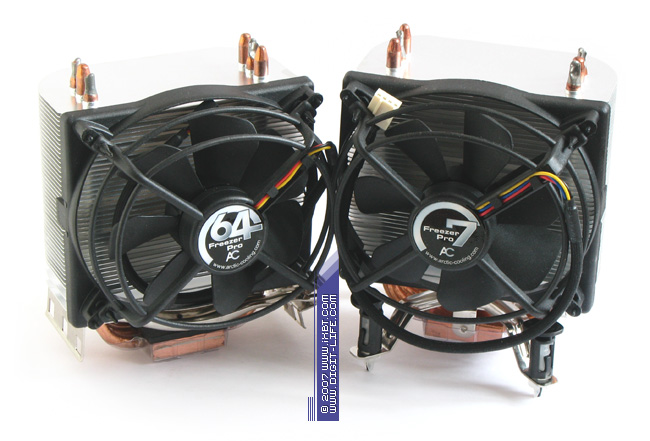 A traditional feature of Arctic Cooling, used in the Freezer Pro, is the open fan (92x92x25 mm), which is mounted on the heat sink with special rubber dampers. That is, noise characteristics of the cooler are improved mechanically. 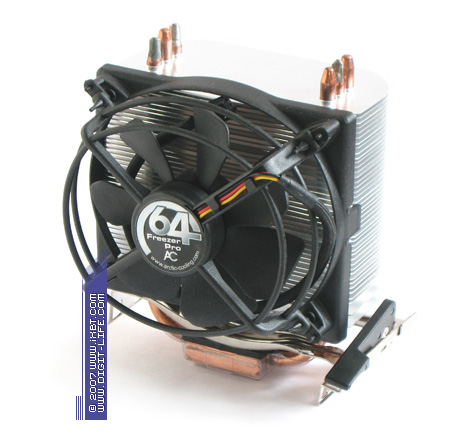
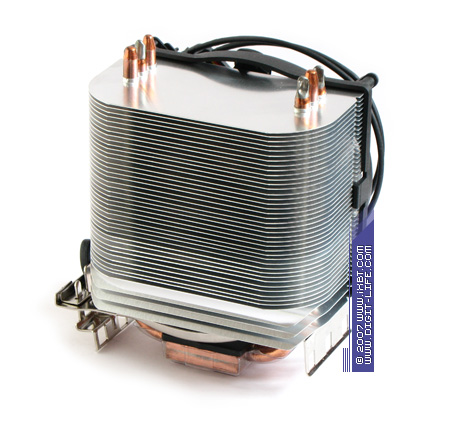 Arctic Cooling engineers also came up with an interesting solution to provide additional cooling for near-socket components. They just bent three bottom fins to direct some of the air flow to the socket area (according to our tests, this trick really works—near-socket components really feel better!) 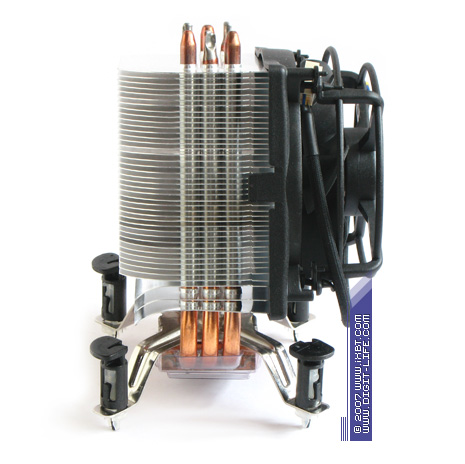 The copper heat sink also looks good—the heat pipes are thoroughly soldered all around the thermal contact (by the way, the heat sink is formed by two soldered plates) to ensure truly minimized thermal resistance in the base-pipe segment. Pipes are just pressed tight into the fins (with the total heat exchange surface area of about 4700 cm2), but they still provide a proper thermal contact. 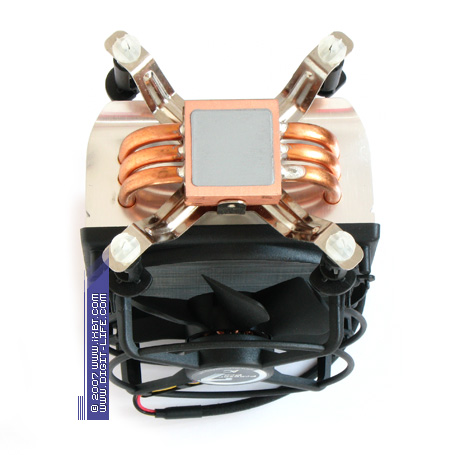 All these peculiarities have a good effect on performance of the Freezer 7 Pro—it demonstrates very good results operating at its nominal speed, coming close to High-End coolers. The Freezer 7 Pro and Freezer 64 Pro also perform well at 2200 rpm (nominal mode for the Freezer 64 Pro), achieving a respectable balance of thermal results and noise ergonomics. As a result, both coolers offer an attractive combination of technical properties, worthy of attention from computer enthusiasts. ASUS Triton 70The next cooler to be reviewed here is an ASUS representative—Triton 70. This cooler is based on a copper heat sink (38x35x2 mm), three heat pipes (6 mm in diameter), 40 aluminum fins (90x50 mm). It comes with a multiplatform retention module (two brackets with reference latches for LGA775, and a toolless clip with a lever for Socket AM2). 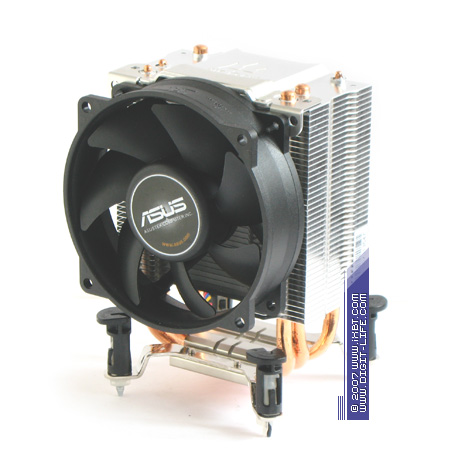 The main attraction of the Triton 70 is its 92x92x25 mm fan (Sunon MagLev KDE1209PTVX), notable for good aerodynamics (designed for optimal noise characteristics), advanced mechanics (Vapo hydrodynamic bearing and MagLev), and good electronics. 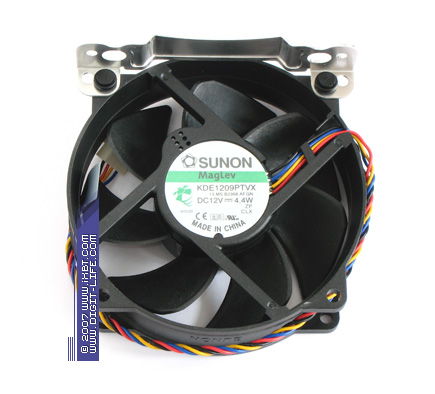 The actuating medium also looks good—the Triton 70 has trapezoid fins to increase heat exchange efficiency. Exterior of the heat sink is also good—fins are pressed tight on the heat pipes, the total heat exchange surface area is about 4000 cm2. 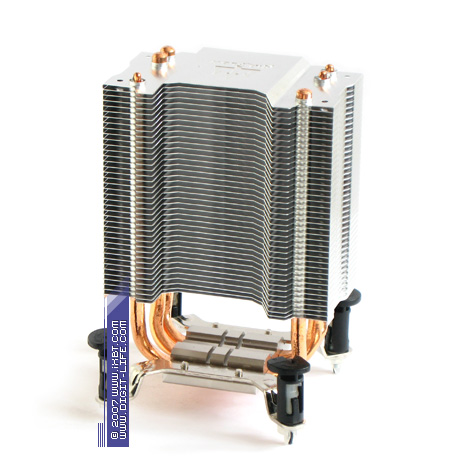
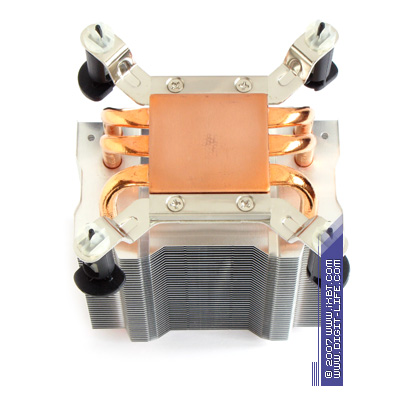 Nevertheless, the Triton 70 is disappointing rather than inspiring as far as its performance is concerned. Although it demonstrates friendly noise characteristics, its thermal efficiency leaves much to be desired. There are apparently some technical flaws (probably weak thermal contact between the base and heat pipes). As a result, our optimistic impressions of the Triton 70 are mostly formed by its neat usability (convenient retention module, low weight, high-quality fan) and adequate price rather than by its purely thermal characteristics. Cooler Master Hyper TX2The next cooler to be reviewed today is the Cooler Master Hyper TX2. This cooler is a successor to the Hyper TX. It's based on the same advanced design - copper heat sink (40x40x4 mm), three copper heat pipes (6 mm in diameter), 41 aluminum fins (90x45 mm. But unlike the predecessors, which were compatible only with one of platforms (Intel or AMD), this cooler comes with a multi-platform retention module (brackets with latches for LGA775 are initially mounted on the base, as well as the removable clip for Socket AM2). 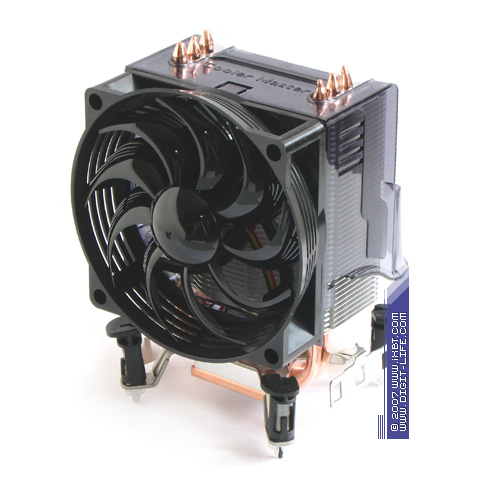 Like the old Hyper TX, the on-board fan of the Hyper TX2 again offers decent parameters—its impeller is optimized for exhaust characteristic and noise ergonomics, it offers decent mechanics (with an improved plain bearing) and neat electronics (the control circuit has smoothing capacitors that damp by-product electromechanical noises—"popping" of the engine). 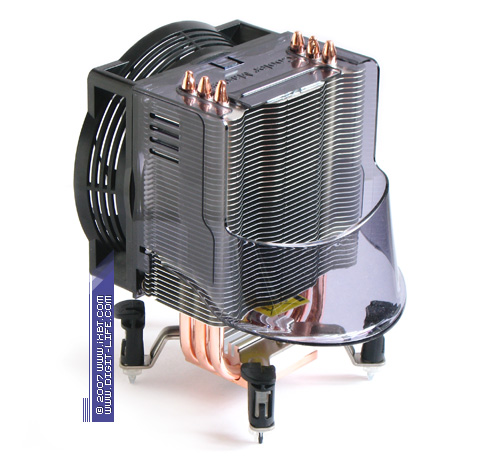 The actuating medium of the Hyper TX2 also looks good—heat pipes are soldered to the heat sink, fins are pressed tight on the pipes; there are several wave-like curves of the fins, the total heat exchange surface area is about 4000 cm2. The only gripe is the plastic apron that extends the housing on heat sink to near-socket components. Theoretically, it must direct the air flow to these elements. But in fact, it does not contribute much to cooling (we didn't notice any significant effect of this apron). 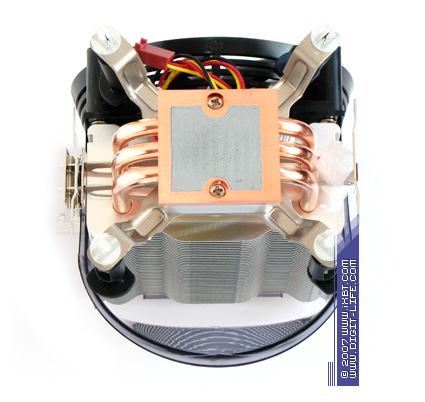 The Hyper TX2 can also boast of interesting thermal results and ergonomic noise characteristics. However, there is one usability problem: the cooler can be easily installed on the AMD platform (the bundled clip is very convenient, so the cooler can be installed really fast), but the latches for Intel are very stiff and require immense efforts to secure the cooler on a motherboard. It may be the problem of a given lot. But our impressions of the Hyper TX2 were spoiled anyway. GlacialTech Igloo 5610 Silent, Igloo 5610 PWM, Igloo 7610 Silent, and Igloo 7610 PWMNow we shall examine new products from GlacialTech—Igloo 5610 Silent and Igloo 5610 PWM. Both coolers are based on the same design - copper heat sink (34x33x2 mm), two heat pipes (6 mm in diameter), 37 compact fins (96x40 mm). They differ in fan speed (1800 rpm and 3200 rpm). The PWM modification is also equipped with the PWM circuit to control fan speed (it varies from 800 rpm to 3200 rpm). 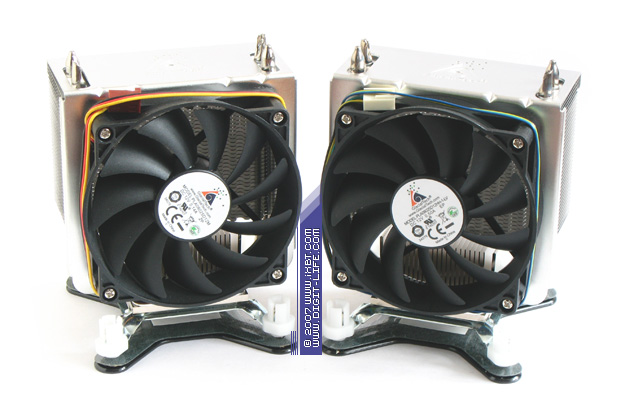 The new Igloo 5610 coolers are modified Igloo 5600 models—they inherited the same ideas, but they slightly modernized them. For example, the on-board fan is replaced with a faster 80x80x20 mm product (in fact, its dimensions with housing are 92x92x20 mm), and the additional heat sink connected to the base has shrunk to 50x50x25 mm. 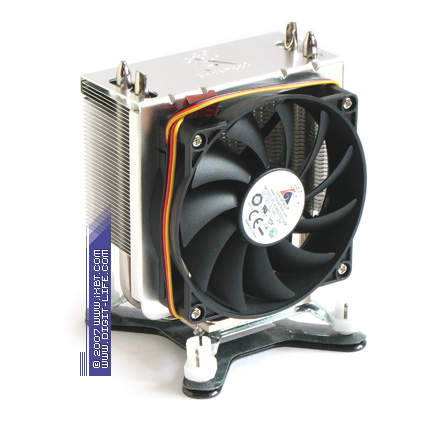
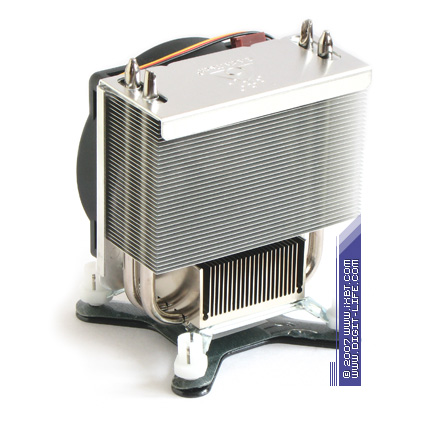 In other respects, the new product is almost an exact copy of the Igloo 5600—well-ventilated compact finning with the developed heat exchange surface area (about 2800 cm2), a rational and effective secondary heat sink (quite complex in itself), good contact between elements (heat sink, pipes, secondary heat sink, fins), and reliable screws. 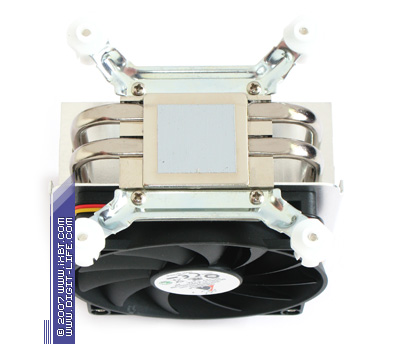 These changes expectably have a positive effect on performance of the Igloo 5610—they offer better thermal results and noise ergonomics. Even though their results are far from outstanding, these products still look good. And if we take into account their attractive usability and good prices, the Igloo 5610 can become one of the leaders of Mid-End coolers with heat pipes. What concerns the Igloo 7610 Silent and Igloo 7610 PWM, they have the same design as the Igloo 5610 Silent/Igloo 5610 PWM, except for their adaptation to AMD (the retention module for Socket AM2 is initially mounted on the base, brackets for Socket 754/939 are included into the bundle). 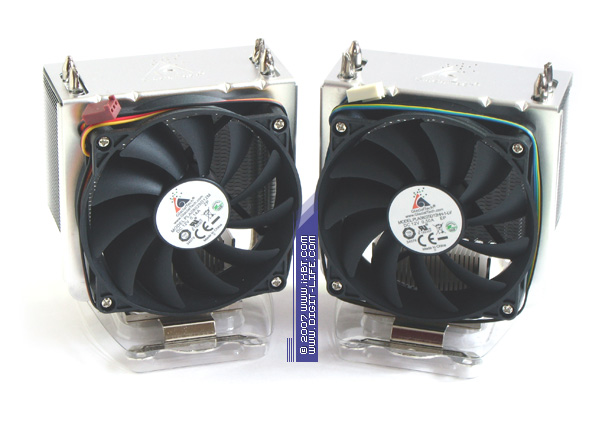 Like the Igloo 5610, the Igloo 7610 Silent and Igloo 7610 PWM demonstrate attractive thermal results, keeping noise characteristics to ergonomic boundaries. 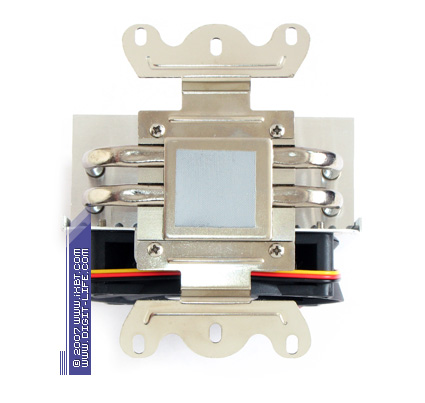 So they are very good products that can compete with many Mid-End coolers for AMD. GlacialTech Igloo 5710 Silent and Igloo 5710 PWMThe next coolers to be examined here are Igloo 5710 Silent and Igloo 5710 PWM. They are based on the advanced design - a copper heat sink (34x33x2 mm), three copper heat pipes (6 mm in diameter), 45 aluminum fins (100x50 mm), and a multi-platform retention module. Like the Igloo 5610, they rank by fan speed (1600 rpm and 2600 rpm). 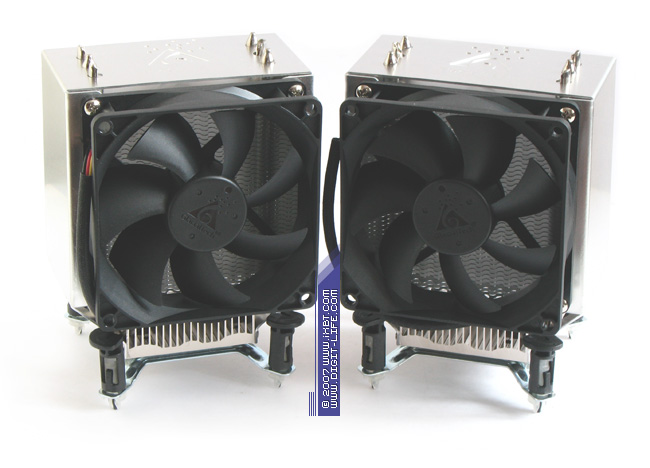 In fact, the new Igloo 5710 develop the Igloo 5700 MC design—the updated configuration copies all older solutions (secondary heat sink to offload heat pipes, optimized finning with the heat exchange surface area of 4500 cm2, good thermal contact between the heat sink, pipes, and fins). And the general outline of modifications is similar to the Igloo 5610. 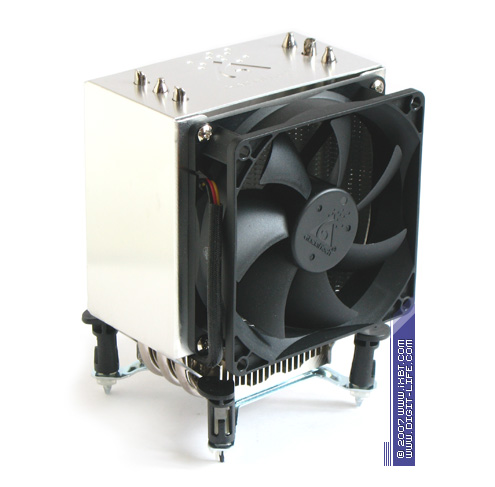
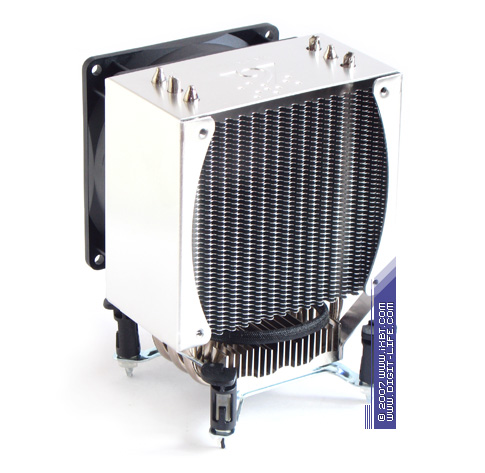 That is, the on-board fan is again replaced with a more efficient model of the same size (92x92x25 mm), but with an improved aerodynamic impeller and hybrid bearing (plain bearing plus rolling bearing). Notice the reincarnation of the secondary heat sink (55x50x18 mm). All these features improve ergonomics of the actuating medium of the Igloo 5710—they allow to drop its weight below 500 g and to add a standard retention module for LGA775, preserving and enhancing imposing functionality of the old Igloo 5700 MC. 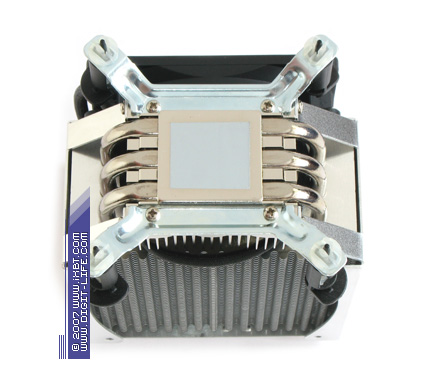 Indeed, the new Igloo 5710 coolers perform very well—they demonstrate excellent thermal efficiency and ergonomic noise results, a respectable efficiency-noise ratio, and they compete well with top coolers. As a result, Igloo 5710 Silent and Igloo 5710 PWM offer balanced functionality (plus reasonable retail prices) and stand up against other average products. Computer enthusiasts should pay close attention to these coolers. GlacialTech Igloo 5750 Silent and Igloo 5750 PWMThe Igloo 5750 Silent and Igloo 5750 PWM are GlacialTech flagships. They are notable for interesting individual designs! 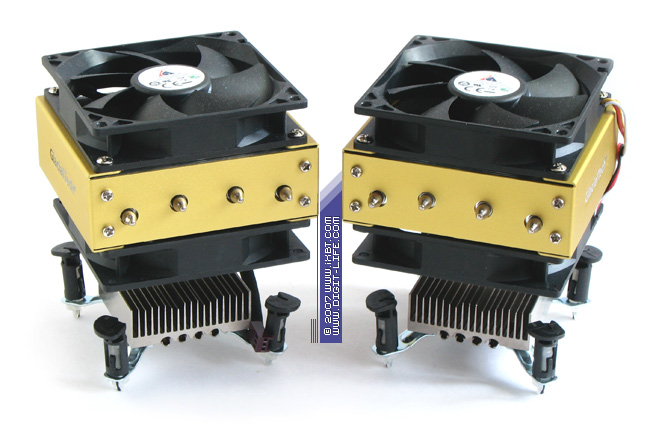 The main attraction of the Igloo 5750 is its advanced (even unique) design: the actuating medium itself is actually quite typical—a copper heat sink (33x33x5 mm), four heat pipes (6 mm in diameter), a secondary heat sink (55x50x18 mm), and horizontal aluminum finning (53 fins, 95x30 mm), but an additional "lower" fan mounted on the finning radically changes the overall image of the cooler. 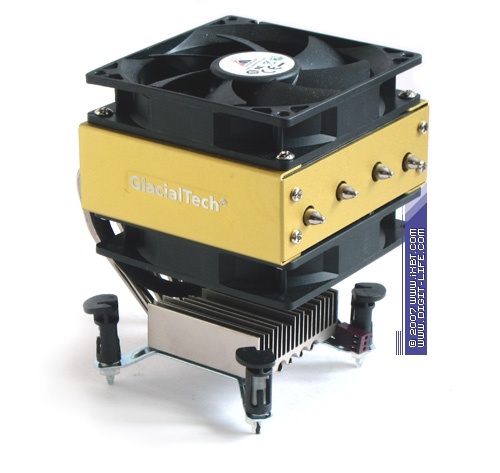 It seems to be a simple idea—just add the second fan to increase the air flow through the fins. In fact, this idea is used in usual tower-like coolers (manufacturers do not add the second fan to the bundle, but you can install it on your own). Nevertheless, the fan sandwich with a horizontal heat sink is currently used only by the Igloo 5750! 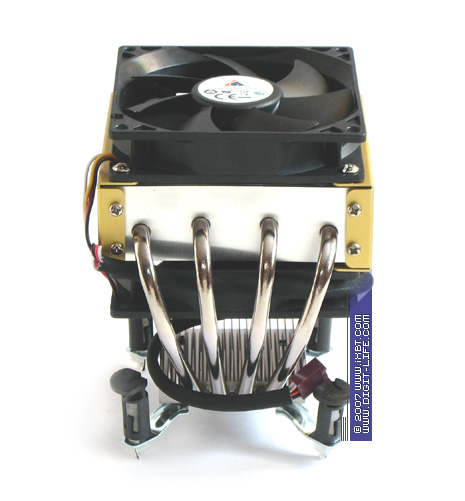 Besides, it has a very good design without bulky finning (where only one third of the heat exchange surface really works) and without a garland of heat pipes. However, it offers good usability (ergonomic dimensions, relatively low weight, a reference retention module) and thermal efficiency. Our tests prove that. The Igloo 5750 PWM performs on a par with the CNPS9700 NT from Zalman in thermal efficiency, keeping its noise within ergonomic limits. And the Igloo 5750 Silent also demonstrates a record-breaking efficiency/noise ratio!  As a result, both Igloo 5750 Silent and Igloo 5750 PWM invade the High-End territory. Besides, they come at reasonable prices. Bravo, GlacialTech! That's the right spirit! Part 2. Products from Scythe, Thermaltake, and Titan
Part 3. Test results (Intel). Summary Table
Part 4. Test results (AMD). Summary Table. Conclusions
Arctic Cooling kindly provided by Arctic Cooling
Vitali Crinitsin (vit@ixbt.com)
January 15, 2008 Write a comment below. No registration needed!
|
Platform · Video · Multimedia · Mobile · Other || About us & Privacy policy · Twitter · Facebook Copyright © Byrds Research & Publishing, Ltd., 1997–2011. All rights reserved. |